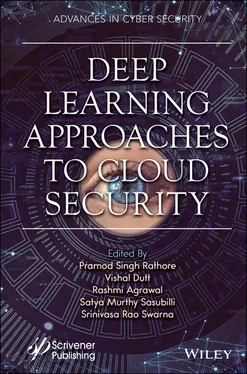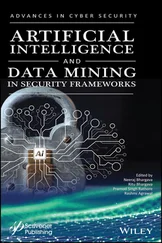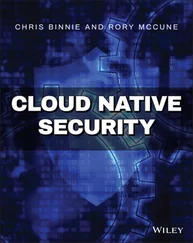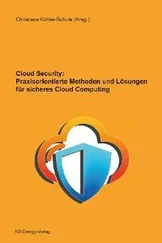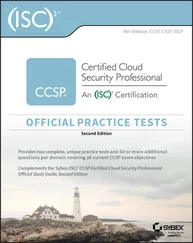In light of its exceptional capacity to recognize people, biometric innovation has quickly become a way to help forestall shams and discovered its place in today’s standard advancements. Consequently, it turns out to be more reliable than the customary validation frameworks that utilize passwords and documents for verification shown in Figure 1.1.
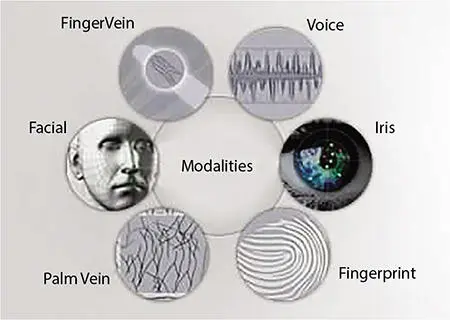
Figure 1.1 Biometric modalities [2].
Physical modalities like fingerprints, voice, faces, veins, iris, hand geometry, and tongue print are unique and provide robust advancements in the field of cyber security [2]. They are useful compared to names, ID numbers, passwords, etc. because they are extraordinary, hard to reproduce, and are more significantly and genuinely bound to the individual.
A computing model which gives on-demand services like information stockpiling, computer power, and infrastructure to associations in the IT industry is termed to be “cloud computing” [3]. Despite the fact that cloud offers a ton of advantages, it slacks in giving security which is an issue for most clients. Cloud clients are hesitant to put classified information up because of looming threats to security.
1.2 Techniques of Biometric Identification
1.2.1 Fingerprint Identification
An automated technique for recognizing or affirming the identity of an individual dependent on the examination of two fingerprints is termed as Fingerprint Recognition. Human fingerprints are not easy to manipulate and are nearly unique and durable over a person’s lifetime. They are unique, permanent, easy to acquire, and are a universally acceptable mode of identification [4].
Human fingerprints are difficult to control but remain sturdy over the life of an individual, making them suitable as long stretch markers of human character.
WORKING OF DIFFERENT TYPES OF FINGERPRINT READERS
1 1. Optical Readers’ sensors work using a 2D image of the fingerprint. Algorithms can be utilized to discover novel patterns of lines and edges spread across lighter and hazier zones of the picture
2 2. Capacitive Readers use electrical signals to form the image of fingerprints. As the charges differ in the air gap between the ridges and lines in the finger set over the capacitive plate, it causes a difference in the fingerprint patterns.
3 3. Ultrasound Readers use high frequency sound waves to infiltrate the external layer of the skin which is used to capture a 3D depiction of the fingerprint. It involves the use of ultrasonic pulses using ultrasonic transmitters and receivers.
4 4. Thermal Readers sense the temperature difference between fingerprint valleys and ridges on making a contact. Higher power consumption and a performance reliant on the surrounding temperature are impediments for these readers.
The iris is a shaded, flimsy, roundabout structure of the eye which controls light entering the retina by regulating the diameter and size of the pupil. It doesn’t change its appearance over a range of an individual’s lifetime except if harmed by external components [5]. Hereditarily indistinguishable twins also have distinctive iris designs. The irises of two eyes of an individual are also unique. Iris recognitionis an automated method of identifying unique intricate patterns of an individual’s iris using mathematical pattern-recognition techniques.
WORKING OF IRIS READERS
1 1. Scan an individual’s eyes with subtle infrared illumination to obtain detailed patterns of iris.
2 2. Isolate iris pattern from the rest of the picture, analyze, and put in a system of coordinates.
3 3. Coordinates are removed using computerized data and in this way an iris mark is produced.
Even on disclosure, one cannot restore or reproduce such encrypted iris signatures. Now the user just needs to look at the infrared camera for verification. Iris acknowledgment results in faster coordination and is extremely resistant to false matches.
A non-intrusive technique to capture physical traits without contact and cooperation from people discovers its application in the acknowledgment framework. Every face can be illustrated as a linear combination of singular vectors of sets of faces. Thus, Principal Component Analysis (PCA) can be used for its implementation. The Eigen Face Approach in PCA can be utilized as it limits the dimensionality of a data set, consequently upgrading computational productivity [6].
WORKING OF FACIAL RECOGNITION TECHNIQUE:
Facial recognition technology identifies up to 80 factors on a human face to identify unique features. These factors are endpoints that can measure variables of a person’s face, such as the length or width of the nose, the distance between the eyes, the depth of the eye sockets and the shape and size of the mouth. In order to measure such detailed factors, complexities such as aging faces arise. To solve this, computers have learned to look closely at the features that remain relatively unchanged no matter how old we get. The framework works by capturing information for nodal points on a computerized picture of a person’s face and storing the subsequent information as a face print [7]. Face print is like a fingerprint but for your face. It accurately identifies the minute differences even in identical twins. It creates 3D models of your face and analyses data from different angles, overcoming many complexities associated with facial recognition technology. The face print is then utilized as a reason for correlation with information captured from faces in a picture or video.
Voice Recognition is a mechanized technique for recognizing or affirming the identity of an individual on the basis of voice. Voice Biometrics make a voiceprint for every individual, which is a numerical representation of the vocal tract of a speaker [8]. This is to ensure correct identification regardless of the language spoken, contents of speech, and wellbeing of an individual.
WORKINGS OF VOICE RECOGNITION:
1 1. Create a voice print or “template” of a person’s speech.
2 2. Only when a user opts in or enlists himself, a template is created, encrypted, and stored for future voice verification.
3 3. Ordinarily, the enlistment process is passive, which means a template can be created in the background during a client’s ordinary cooperation with an application or operator.
The utilization of voice biometrics for identification is expanding in fame because of enhancements in precision, energized to a great extent by evolution of AI, and heightened customer expectations for easy and fast access to information [9].
Large amounts of data can diminish the efficiency of data mining and may not provide significant inputs to the model. Non-essential attributes add noise to the data, expanding the size of the model. Moreover, model building and scoring leads to consumption of time and system resources, influencing model precision.
Likewise, huge data sets may contain groups of attributes that are associated and may quantify a similar hidden component which can skew the logic of the algorithm. The computation cost associated with algorithmic processing increases with higher dimensionality of processing space, posing challenges for data mining algorithms. Impacts of noise, correlation, and high dimensionality can be minimized by dimension reduction using feature selection and feature extraction [10].
Читать дальше
